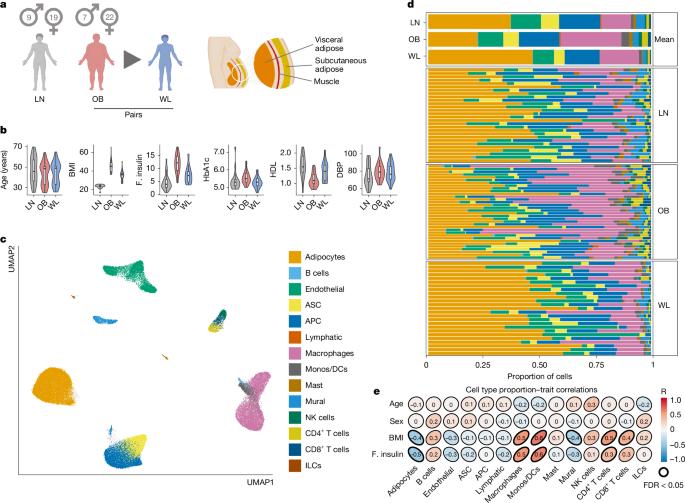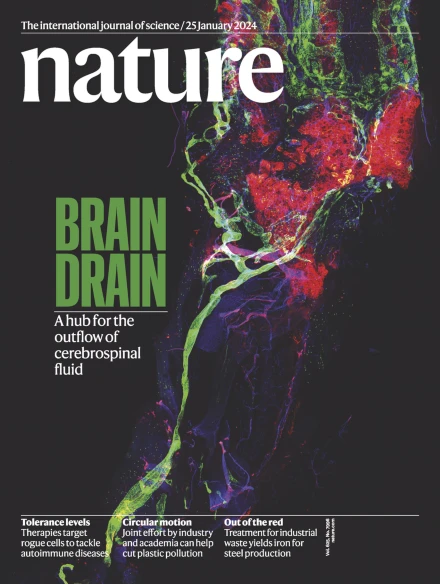Selective remodelling of the adipose niche in obesity and weight loss
IF 48.5
1区 综合性期刊
Q1 MULTIDISCIPLINARY SCIENCES
引用次数: 0
Abstract
Weight loss significantly improves metabolic and cardiovascular health in people with obesity1–3. The remodelling of adipose tissue (AT) is central to these varied and important clinical effects4. However, surprisingly little is known about the underlying mechanisms, presenting a barrier to treatment advances. Here we report a spatially resolved single-nucleus atlas (comprising 171,247 cells from 70 people) investigating the cell types, molecular events and regulatory factors that reshape human AT, and thus metabolic health, in obesity and therapeutic weight loss. We discover selective vulnerability to senescence in metabolic, precursor and vascular cells and reveal that senescence is potently reversed by weight loss. We define gene regulatory mechanisms and tissue signals that may drive a degenerative cycle of senescence, tissue injury and metabolic dysfunction. We find that weight loss reduces adipocyte hypertrophy and biomechanical constraint pathways, activating global metabolic flux and bioenergetic substrate cycles that may mediate systemic improvements in metabolic health. In the immune compartment, we demonstrate that weight loss represses obesity-induced macrophage infiltration but does not completely reverse activation, leaving these cells primed to trigger potential weight regain and worsen metabolic dysfunction. Throughout, we map cells to tissue niches to understand the collective determinants of tissue injury and recovery. Overall, our complementary single-nucleus and spatial datasets offer unprecedented insights into the basis of obese AT dysfunction and its reversal by weight loss and are a key resource for mechanistic and therapeutic exploration. An atlas study of adipose tissue in people with obesity undergoing weight loss and their lean counterparts reveals that weight loss reduces cell senescence but cannot reverse all the metabolic problems caused by obesity.


肥胖和减肥中脂肪生态位的选择性重构
减肥可显著改善肥胖人群的代谢和心血管健康1,2,3。脂肪组织(AT)的重塑是这些多样而重要的临床效果的核心。然而,令人惊讶的是,人们对其潜在机制知之甚少,这对治疗进展构成了障碍。在这里,我们报告了一个空间分辨率的单核图谱(包括来自70人的171,247个细胞),研究了重塑人类AT的细胞类型、分子事件和调节因素,从而改变了肥胖和治疗性减肥中的代谢健康。我们发现代谢细胞、前体细胞和血管细胞对衰老的选择性脆弱性,并揭示衰老可以通过减肥有效地逆转。我们定义基因调控机制和组织信号,可能驱动退化周期的衰老,组织损伤和代谢功能障碍。我们发现体重减轻减少脂肪细胞肥大和生物力学约束途径,激活全球代谢通量和生物能量底物循环,可能介导代谢健康的系统性改善。在免疫区,我们证明了减肥抑制肥胖诱导的巨噬细胞浸润,但不能完全逆转激活,使这些细胞准备触发潜在的体重恢复和恶化代谢功能障碍。在整个过程中,我们将细胞映射到组织壁龛,以了解组织损伤和恢复的集体决定因素。总的来说,我们的互补单核和空间数据集为肥胖AT功能障碍的基础及其通过减肥逆转提供了前所未有的见解,并且是机制和治疗探索的关键资源。
本文章由计算机程序翻译,如有差异,请以英文原文为准。
求助全文
约1分钟内获得全文
求助全文
来源期刊

Nature
综合性期刊-综合性期刊
CiteScore
90.00
自引率
1.20%
发文量
3652
审稿时长
3 months
期刊介绍:
Nature is a prestigious international journal that publishes peer-reviewed research in various scientific and technological fields. The selection of articles is based on criteria such as originality, importance, interdisciplinary relevance, timeliness, accessibility, elegance, and surprising conclusions. In addition to showcasing significant scientific advances, Nature delivers rapid, authoritative, insightful news, and interpretation of current and upcoming trends impacting science, scientists, and the broader public. The journal serves a dual purpose: firstly, to promptly share noteworthy scientific advances and foster discussions among scientists, and secondly, to ensure the swift dissemination of scientific results globally, emphasizing their significance for knowledge, culture, and daily life.
 求助内容:
求助内容: 应助结果提醒方式:
应助结果提醒方式:


